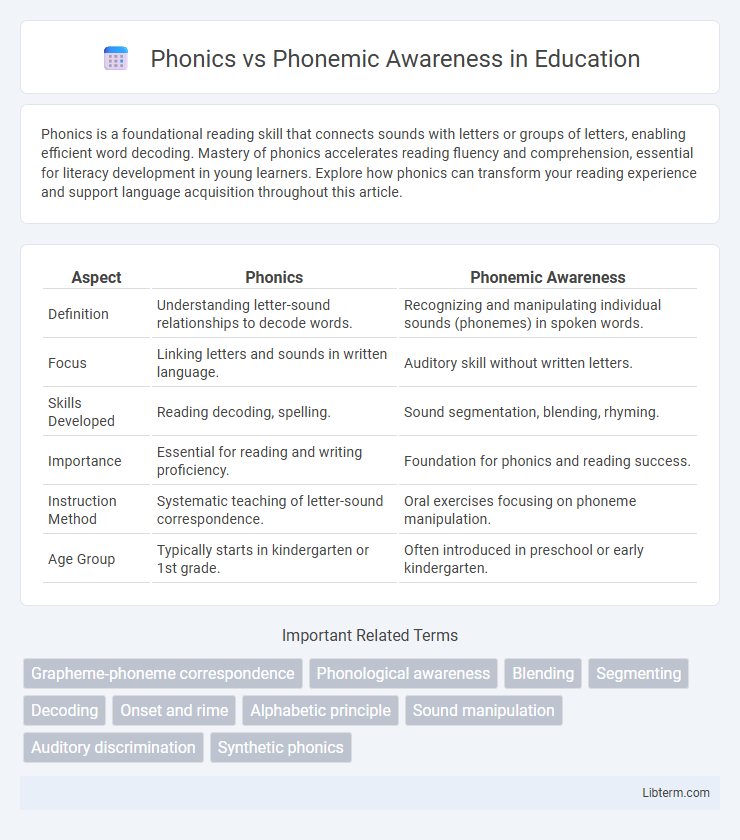Phonics is a foundational reading skill that connects sounds with letters or groups of letters, enabling efficient word decoding. Mastery of phonics accelerates reading fluency and comprehension, essential for literacy development in young learners. Explore how phonics can transform your reading experience and support language acquisition throughout this article.
Table of Comparison
| Aspect | Phonics | Phonemic Awareness |
|---|---|---|
| Definition | Understanding letter-sound relationships to decode words. | Recognizing and manipulating individual sounds (phonemes) in spoken words. |
| Focus | Linking letters and sounds in written language. | Auditory skill without written letters. |
| Skills Developed | Reading decoding, spelling. | Sound segmentation, blending, rhyming. |
| Importance | Essential for reading and writing proficiency. | Foundation for phonics and reading success. |
| Instruction Method | Systematic teaching of letter-sound correspondence. | Oral exercises focusing on phoneme manipulation. |
| Age Group | Typically starts in kindergarten or 1st grade. | Often introduced in preschool or early kindergarten. |
Introduction to Phonics and Phonemic Awareness
Phonics teaches the relationship between letters and sounds, enabling learners to decode written words by recognizing letter patterns and pronunciation rules. Phonemic awareness focuses on the ability to hear, identify, and manipulate individual sounds--phonemes--in spoken words, a critical skill for developing reading proficiency. Mastery of phonemic awareness is foundational for effective phonics instruction, as it prepares learners to connect sounds with their corresponding letters.
Defining Phonics
Phonics is a method of teaching reading that emphasizes the relationship between letters and their corresponding sounds, enabling learners to decode words by sounding them out. It involves the systematic instruction of letter-sound correspondences, blending, and segmentation to develop reading fluency and accuracy. This foundational skill supports vocabulary development, spelling, and comprehension by helping readers connect spoken language to written text.
Understanding Phonemic Awareness
Phonemic awareness is the ability to hear, identify, and manipulate individual sounds--phonemes--in spoken words, serving as a foundational skill for reading development. Unlike phonics, which involves the relationship between sounds and written letters, phonemic awareness focuses solely on auditory processing without involving text. Mastery of phonemic awareness enhances decoding skills, leading to improved word recognition and spelling proficiency.
Key Differences Between Phonics and Phonemic Awareness
Phonics involves teaching the relationship between letters and their corresponding sounds, enabling children to decode written words, while phonemic awareness is the ability to hear, identify, and manipulate individual sounds, or phonemes, in spoken words without visual cues. Phonemic awareness serves as a foundational skill that supports phonics instruction by enhancing sound segmentation and blending abilities crucial for reading development. Understanding these distinctions helps educators design targeted literacy interventions that address both auditory skills and print decoding.
Why Phonics Matters in Reading Development
Phonics instruction is crucial because it teaches learners the relationship between letters and sounds, enabling accurate decoding of words during reading. Phonemic awareness, while foundational, involves recognizing and manipulating sounds in spoken language without print, which by itself does not provide the skills to decode written text. Effective reading development relies on phonics to bridge spoken language skills with written language, thereby improving reading fluency and comprehension.
The Role of Phonemic Awareness in Early Literacy
Phonemic awareness is a critical foundation for early literacy, enabling children to recognize and manipulate individual sounds in spoken words before they learn to read. It supports the development of decoding skills by helping learners understand the sound structure of language, which is essential for mastering phonics instruction. Research indicates that strong phonemic awareness significantly improves reading fluency, spelling, and comprehension in young readers.
Teaching Strategies for Phonics
Effective teaching strategies for phonics include systematic instruction that emphasizes the relationship between letters and sounds, using multisensory activities like letter-sound mapping and blending exercises to reinforce decoding skills. Incorporating explicit modeling, guided practice, and immediate feedback helps students master phoneme-grapheme correspondences and apply them to reading and spelling. Differentiated instruction and frequent assessments ensure phonics instruction meets diverse learner needs, fostering strong foundational reading abilities.
Effective Activities for Building Phonemic Awareness
Effective activities for building phonemic awareness include phoneme segmentation, blending exercises, and manipulating sounds within words to enhance auditory discrimination. Using tools such as rhyming games, sound matching, and syllable clapping helps children recognize and manipulate individual sounds, which is essential for reading development. These phonemic awareness activities are critical in early literacy as they prepare learners to decode words accurately and improve spelling skills.
Common Misconceptions About Phonics and Phonemic Awareness
Many confuse phonics with phonemic awareness, mistakenly believing they are interchangeable when phonics involves linking sounds to letters, while phonemic awareness is the ability to hear and manipulate sounds without print. A common misconception is that phonics instruction alone ensures reading success, ignoring the essential role of phonemic awareness in developing decoding skills. Research shows that strong phonemic awareness is a predictor of reading proficiency, highlighting its foundational importance beyond just phonics.
Integrating Phonics and Phonemic Awareness in the Classroom
Integrating phonics and phonemic awareness in the classroom enhances early literacy development by combining the recognition of sounds with their corresponding letter patterns. Research shows that teaching phonemic awareness alongside phonics improves decoding skills and reading fluency by reinforcing sound-letter relationships. Effective strategies include using multisensory activities that emphasize segmenting sounds and blending letter-sound correspondences, promoting comprehensive reading proficiency.
Phonics Infographic

 libterm.com
libterm.com